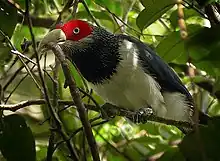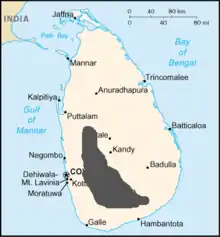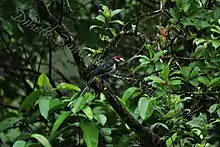Red-faced malkoha
The red-faced malkoha (Phaenicophaeus pyrrhocephalus) is a member of the cuckoo order of birds, the Cuculiformes. This malkoha species is endemic to Sri Lanka
| Red-faced malkoha | |
|---|---|
 | |
| Scientific classification | |
| Domain: | Eukaryota |
| Kingdom: | Animalia |
| Phylum: | Chordata |
| Clade: | Dinosauria |
| Class: | Aves |
| Order: | Cuculiformes |
| Family: | Cuculidae |
| Genus: | Phaenicophaeus |
| Species: | P. pyrrhocephalus |
| Binomial name | |
| Phaenicophaeus pyrrhocephalus (Pennant, 1769) | |
 | |
Description

This is a large species at 46 cm with a long graduated tail. Its back is dark green, and the uppertail is green edged with white. The belly and undertail are white, the latter being barred black. The crown and throat are black, and the lower face white. There is a large red patch around the eye and the bill is green. Sexual dimorphism present where males are having dark brown iris and females are with creamy white iris. Juveniles are with much duller plumage.[2]
The red-faced malkoha takes a variety of insects including caterpillars, giant stick insects, mantises and small vertebrates such as lizard. It occasionally may eat berries but this needs confirmation.[3]
Unlike most cuckoos, this is a quiet species, making only the odd soft grunt.[3]
Distribution
It is endemic to Sri Lanka although some old records have apparently erroneously referred to its presence in southern India.[4] According to Baker (1934),[5] it is found in the 'South of Travancore, where it was obtained by Stewart together with its nests'. Later, Biddulph[6] reported a red-faced malkoha in Madurai district, southern Tamil Nadu. Thilo Hoffmann later[7] pointed out that this record would not stand up to a modern records committee, and it is now best disregarded.[8]
The presence of red-faced malkoha in the island is largely confined to the Sinharaja Forest Reserve and the surrounding vegetation, which is one of the biodiversity hotspots in the world.

Habitat
The red-faced malkoha is a bird of dense forests, where it can be difficult to see despite its size and colour. It prefers low country wet zone forests, sub-montane forests, montane forests and riverine forests in few dry zone forests in Sri Lanka. It can be seen in most of the largest rain forest patches in the wet zone and in dry zone Yala National Park, Lahugala National Park, Wasgamuwa National Park and Udawalawe National Park.[2]
Breeding biology
It makes a deep cup nest in a well concealed foliage in sub canopy level, generally between 5-12 m height. The typical clutch being 2-3 eggs. Both male and females are engaging in nest building process.[2]
Behaviour
They are found in nearly half of the mixed-species foraging flocks in the Sinharaja area.[9] Most of the individuals of Red-faced Malkohas which participate in the mixed-species bird flocks tend to prefer in the front of the flock. There is a high probability to see this cryptic bird in the flock if you observe the front half of the flock. [2]
In culture
The common name for this species malkoha is the vernacular name for the bird in Sinhala language.[10] 'Mal-Koha' translates to 'flower-cuckoo'. The red-faced malkoha appears in a 5 rupee Sri Lankan postal stamp.[11]
References
- BirdLife International (2016). "Phaenicophaeus pyrrhocephalus". IUCN Red List of Threatened Species. 2016: e.T22684123A93015295. doi:10.2305/IUCN.UK.2016-3.RLTS.T22684123A93015295.en. Retrieved 12 November 2021.
- Dayananda, Salindra (2023) Red-faced Malkoha: A Sri Lankan Endemic Bird
- Salgado, Amila (2006) Some observations on the diet of Red-faced Malkoha Phaenicophaeus pyrrhocephalus in Sri Lanka. Forktail 22:122-123 PDF
- Hoffmann, T. W. (1997) Red-faced Malkohas. Newsletter for Birdwatchers 37(1): 14-15.
- Baker, E.C.S. 1934. Nidification of birds of the Indian Empire. Vol III, Taylor & Francis, London.
- Biddulph, C.H. (1956). "Occurrence of the Red-faced Malkoha, Phoenicophaus pyrrhocephalus (Pennant) in Madura district, Madras presidency". Journal of the Bombay Natural History Society. 53: 697–698.
- Hoffmann, T.W. (1996). "New bird records in Sri Lanka and some connected matters". Journal of the Bombay Natural History Society. 93: 382–388.
- Erritzoe, J. & Fuller, R.A. (1997). "Little-known Oriental bird: Red-faced Malkoha". Bulletin of the Oriental Bird Club. 26: 35–39.
- Kotagama, S. W. & Goodale, E. (2004). "The composition and spatial organization of mixed species flocks in a Sri Lankan rainforest" (PDF). Forktail. 20: 63–70.
- Anonymous (1998). "Vernacular Names of the Birds of the Indian Subcontinent" (PDF). Buceros. 3 (1): 53–109. Archived from the original (PDF) on 1 April 2010.
- "Birds on stamps: Sri Lanka".
